
views
- Position the ball in the center of your stance for your mid-irons, slightly forward for your low-irons, and slightly back for high-irons and wedges.
- Keep your arms extended during your swing so the club head travels in a smooth, gradual arc instead of at a steep angle.
- Lead with your hips on your downswing, and try to make a sweeping motion through the ball to hit it squarely with the club head.
Rotate your full body for a powerful downswing.
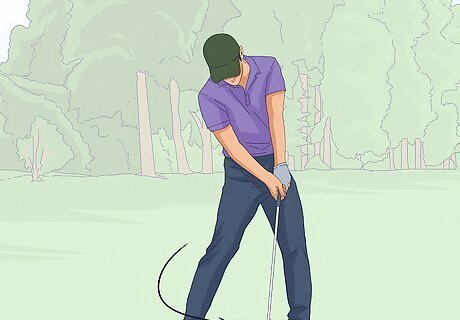
Turning your body as you hit the ball ensures you get the most power. Bring the club head back down along the same arcing path that you used on your backswing so your shot stays straight. As you’re swinging down, open your shoulders and hips by shifting most of your weight back to your front foot. When you hit the ball, keep your back shoulder lower than your front and turn your chest toward your target.
Extend your hands out during your backswing.
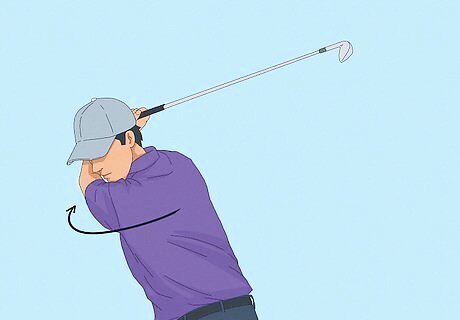
Keeping your arms straight adds more width to your backswing. Width is the distance between your club and your chest, and more width helps you hit the ball squarely. When you’re ready to swing the club, keep your arms straight as you twist your upper body. Shift your weight towards your back leg as you take a full backswing, bringing the club above your head.Try to maintain the same distance from your chest to the club so you have a smooth arc on the backswing. Practice a few half-backswings to loosen up before you actually hit the ball. At the top of your backswing, it’s normal to slightly bend your dominant arm at the elbow and keep your non-dominant arm straight. Keep a firm grip at the top of your swing instead of letting your wrists break. Loosening your grip will make your downswing narrower so you won’t get as much power from your swing.
Sweep through the ball to finish your shot.

Following through with your swings helps you get more distance. Rather than stopping your downswing once you make contact, keep the club head moving forward through the ball toward your target. Try to hit the ball when your club is at the lowest point of your downswing. When you finish your swing, make sure your belt buckle or button of your pants faces the target. If your hips are out of position, then focus on leading the turn with your hips on your next swing. Think of your club head like a plane landing on the runway. Rather than coming down at a sharp angle on your downswing, try to make a gentle, shallow arc through the ball. It’s okay to leave a divot behind after you already hit the ball. If you hit the ground before making contact with your ball, then you’re bringing the club down too sharply. Avoid trying to scoop the ball up with your club to get it higher in the air, or else you may lose distance from your shot.
Practice swinging drills to improve consistency.
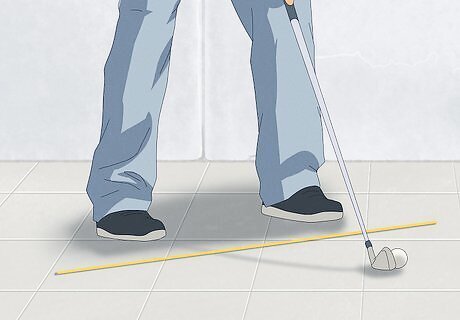
Running drills helps you detect and fix issues with your swing. Rather than waiting until you’re on the course, try doing practice swings at home or at the driving range. As you work through drills, focus on your club’s alignment, body posture, and the path of your swing to see where you can improve. Some easy drills include: Alignment Stick drill: Lay an alignment stick pointing toward your target on one side of your ball. Lay another stick parallel to the first just in front of your feet. Try a few practice swings, and keep the club’s face traveling along the first alignment stick each time. Towel drill: Fold a towel in half and wrap it around your chest so the ends tuck under your armpits. Try to keep the towel pinched tightly throughout your swing so it doesn’t fall down. This helps you maintain a consistent, straight swing. Divot pattern drill: As you practice swinging at a driving range, look at the divot after each shot. If the divot is curved or pointed away from the center, adjust the path of your swing until the divots look straight.
Keep a firm grip on your club.
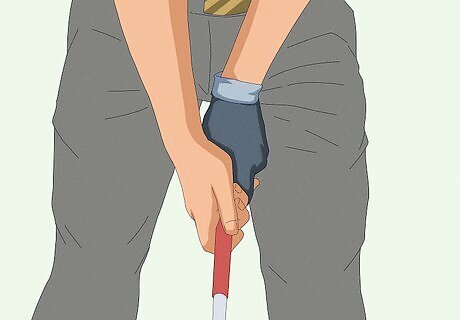
A strong grip ensures your iron won’t turn or shift during your swing. Straighten out the head of your club so it’s aiming toward your target. Hold the club firmly with your non-dominant hand about 1–2 inches (2.5–5.1 cm) from the end of the club and your thumb on top of your grip. Then, position your dominant hand just ahead of the other on the lower part of the grip so your little finger and index finger are touching. To tell if you’re gripping your club properly, look at the V-shape formed by the thumb and pointer finger on your dominant hand. Adjust your grip so the V points toward the shoulder on the same side of your body. Avoid squeezing the club really tightly because it could make you pull your shots.
Maintain an athletic shoulder-width stance.

Having your feet below your shoulders gives a strong, sturdy base. Set the iron’s head behind your golf ball and stand a step or two back from the ball. Position your feet directly below your shoulders so most of your weight is on your front foot to create a strong foundation for your swing. Keep your knees slightly bent and your back straight. Bend forward at the hips until your arms can comfortably hang straight down. Standing with your feet too close together or far apart may throw off your balance and prevent you from getting power during your swing. Irons have shorter shafts than drivers, so try standing a little closer to the ball to ensure you make good contact during your swing.
Line the side of your body up with your target.
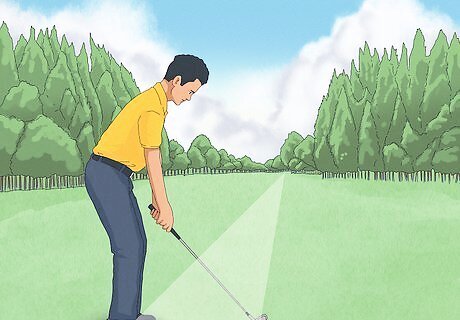
Aligning your body with your target stops you from overswinging. When you’re getting into your stance, picture an imaginary line running from the side of your body to where you want the ball to go. Position your front shoulder so it’s pointing right where you want the ball to go. This keeps your hips from turning too far back on your backswing. Lay your club down so it touches the toe of each shoe. Look where the end of the club is pointing to determine where you’re aiming.
Put the ball closer to your front foot for lower irons.

Placing the ball forward ensures the club makes good contact. You’ll get the most control and consistency from iron shots if the club’s face is squared off when you hit the ball. If you’re using your 5- or 6-iron, position the ball directly centered between your feet. When you swing a 3- or 4-iron, adjust your feet so the ball is 1–2 inches (2.5–5.1 cm) to your front foot. When you shoot a wedge or a short iron, stand so the ball is 1 inch (2.5 cm) closer to your back foot instead. Catching the ball on the downswing means hitting it before your club starts swinging up again. If you’re already on your upswing when you contact the ball, you may only hit the top and go a short distance. If you’re wearing a golf shirt with a logo, position the ball in line with your shirt’s buttons for a 5- or 6-iron. For a 3- or 4-iron, position the ball between the shirt buttons and the logo.




















Comments
0 comment